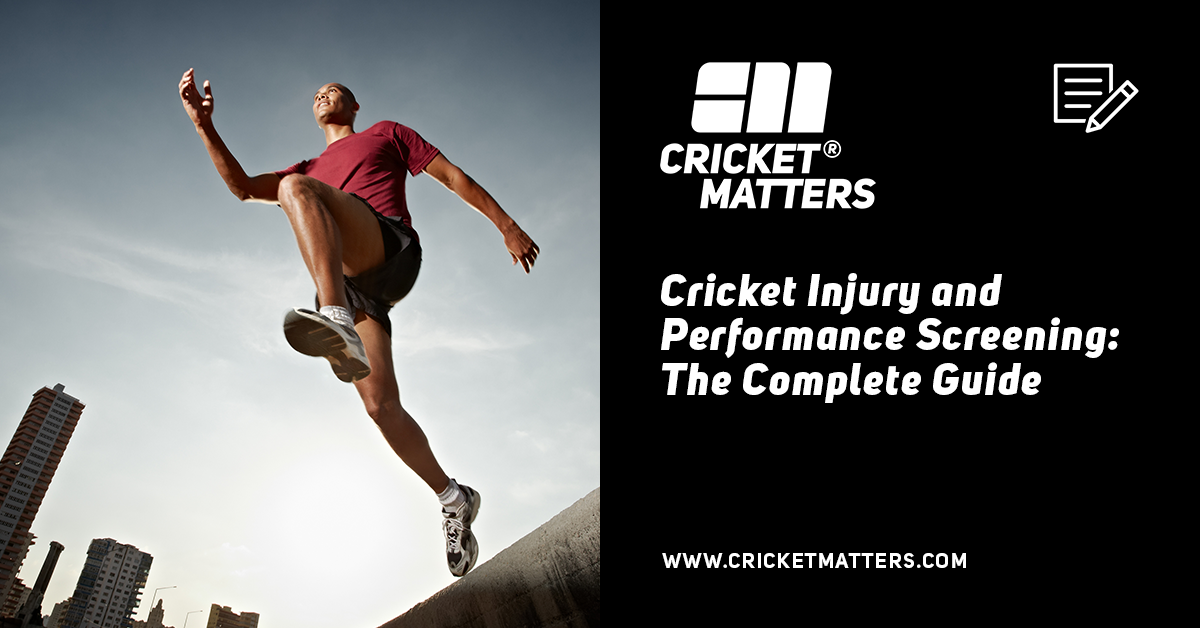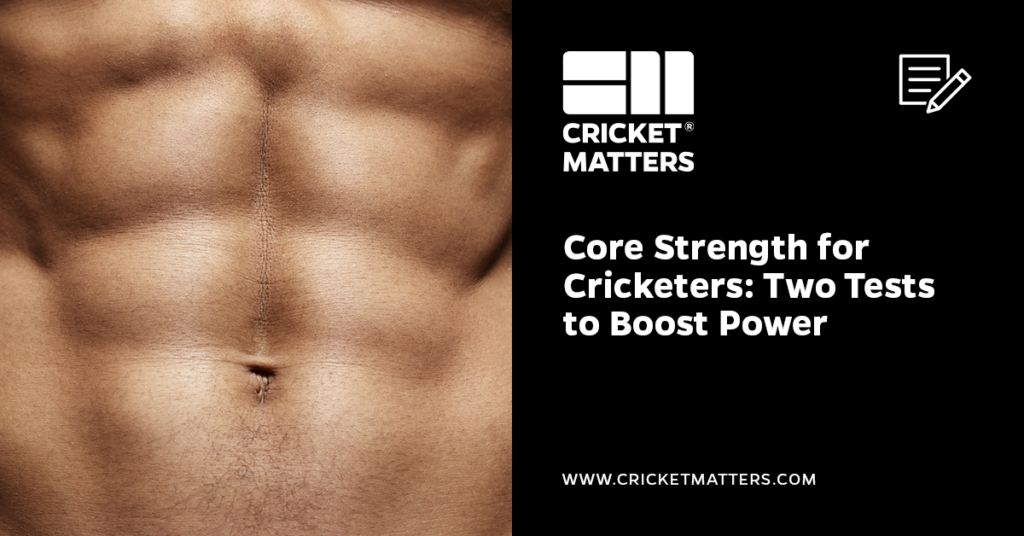
I hope you enjoy reading this blog post.
James Breese, Cricket Matters FounderIf you need my help with cricket coaching, strength and conditioning, injury rehab, or nutrition, click here.
Cricket is brutal in repetition. Bowlers’ backs, batters’ groins and hamstrings, keepers’ knees — the same areas break down, season after season. It’s not if, it’s when.
That’s why injury and movement screening matters. It shows you how a player moves, where the risks are hiding, and what needs fixing before pain or breakdown stops play. Tight hips, unstable ankles, weak links in the chain — they all show up here first.
This isn’t just about avoiding injury. Done right, screening builds a roadmap for performance: the strength to bowl longer spells, the mobility to rotate smoothly, the control to move with confidence. No cookie-cutter gym programs — just plans built for your body and your role.
At Cricket Matters, we start every player with a Performance Analysis, or an Injury Analysis if pain is already present. It’s the foundation for everything else — because when you know how a body moves, you know how to build it stronger.
Cricket is brutal in repetition. Screening shows the weak links before they break.
Table of Contents
What Is Cricket Injury and Performance Screening?
Cricket injury and performance screening is a structured check-up for how your body moves and performs. Think of it as an MOT for cricketers — simple tests that show where you’re strong, where you’re stiff, and where small issues could grow into injuries.
The goal isn’t just to prevent breakdowns. Screening gives you a performance baseline: how well you balance, how much power you produce, and whether your movement quality can handle the demands of bowling, batting, and fielding. From there, you can train smarter, fix weak links, and track progress over time.
It also links directly to technique. Just as TPI in golf connects swing faults to body restrictions, cricket screening shows how your movement shapes your game. A batter who can’t rotate their hips freely struggles with front-foot play. A bowler with limited thoracic mobility overloads their lumbar spine. A keeper without ankle range can’t hold a low crouch. What looks like a technical flaw is often a physical limitation.
And that’s the point: screening isn’t about diagnosis, it’s about connection — spotting how movement quality underpins performance, and where adjustments will keep you playing better, longer, and pain-free.
The “Holy Trinity” of Movement Screening (FMS, SFMA, YBT)
There are dozens of screening systems out there, but from my experience working with Gray Cook and the FMS team in the USA, only a few truly stand the test of time. There’s a reason these same methods form part of the NFL and MLB combines — and why clubs like Bayern Munich build them into their player monitoring. When performance and availability matter, the system has to be proven.
At Cricket Matters, we use what I call the “holy trinity” of movement screening:
- FMS (Functional Movement Screen) → For pain-free athletes. It gives a clean baseline of movement quality: where you’re symmetrical, where you compensate, and how ready your body is to handle load.
- SFMA (Selective Functional Movement Assessment) → For athletes with pain. Instead of just noting a fault, it digs into why the pain exists — mobility vs stability, compensation vs control.
- Y-Balance Test (YBT) → The precision tool. It measures dynamic balance and single-leg symmetry with accuracy, making it invaluable for return-to-play and for the highest-performing athletes chasing that extra 1%.
Here’s how it works in practice: say a bowler comes in with recurring back pain. The FMS might flag a poor deep squat pattern. That tells us something is off, but not why. The SFMA then digs deeper and reveals the real driver — limited hip rotation forcing the lumbar spine to do the work. Later, once pain is under control, the YBT is used to check single-leg balance and asymmetry before return-to-play.
And it’s not just about injury. This system helps explain technique too. We always ask three questions: What is the player doing? How are they doing it? Why are they doing it that way? The holy trinity lets us answer the “why.” It shows whether a technical fault — like a batter constantly losing balance — is really about skill, or whether it’s a mobility or stability issue holding them back.
That’s the difference: it’s not random screens, it’s a system. Everyone on the team speaks the same language, follows the same roadmap, and gives players clarity they can trust.
This system is built into every screen we run at Cricket Matters — so whether you’re pain-free, dealing with a niggle, or chasing that extra 1%, we’ve got a proven roadmap.
The holy trinity of screening — FMS, SFMA, and Y-Balance — gives players clarity they can trust.
Beyond Movement — Power, Speed and Aerobic Testing
Movement screens like FMS, SFMA, and Y-Balance give us the “why” — they show weak links, asymmetries, and patterns that predict where a body will break down. But cricket isn’t just about moving well in a test — it’s about holding those patterns when you’re under fatigue, pressure, and repetition.
That’s where performance screening comes in. These tests form part of the initial assessments we run at Cricket Matters. They sit alongside our movement and injury screens to give us a complete physical snapshot of the athlete. From there, we can go deeper once training begins.
Why does it matter? Because most cricketers fall into one of three categories:
- Broken (already injured and can’t perform)
- Breaking (niggles building up but still playing)
- Balanced (moving and performing in sync)
Our job is to shift players into that balanced category — because that’s where performance thrives. The problem is, many players don’t know they’re breaking until they’re broken. And even those who know they’re broken often don’t know how to get out of it.
These tests shine a light on the problem. If your broad jump is way below par, it often shows up in bowling stride length or batting power. If your farmer’s carry falls short, posture will collapse in long innings. Fix the gaps, and not only does injury risk drop — technique improves too. And that’s what most cricketers are obsessed with: hitting cleaner, bowling faster, moving sharper.
This is why we don’t separate “injury screening” from “performance screening.” They’re two sides of the same coin. Together, they explain why a technique fault exists, and what needs to change physically to fix it for good.
Cricket Screening Benchmarks — Test, Standard, Why It Matters
| Test | Benchmark (Baseline → Elite) | Why It Matters in Cricket |
| Broad Jump | 110% of height → 120%+ | Lower-body power. Links directly to bowling drive, batting explosiveness, and fielding. |
| Med Ball Side Throw (Rotation) | Women: 2kg 10m+ → 12m+; Men: 4kg 10m+ → 14m+ | Shows hip–trunk–shoulder connection. Poor scores = leaked energy, slower bowling, weaker bat speed. |
| Farmer’s Carry (75% BW) | 90s → 120s+ | Tests postural stabilisers under fatigue. Weak here = collapsed technique late in games. |
| 30m Sprint Test | <4.5s → <4.0s | Acceleration wins run-outs, stopping boundaries, and momentum through the crease. |
| Run-a-3 Test | <25s → <22s | Simulates repeat accelerations, turns, and decision-making between wickets. |
| 300-Yard Shuttle | <65s → <60s | Brutal aerobic power test. Poor recovery here = heavy legs in the field. |
| 2km Time Trial | <10 mins → <8 mins | Aerobic capacity benchmark. Links to recovery between overs, innings, and matches. |

Have You Downloaded Our FREE 7-Day Gym Workout Plan?
Grab your complete step-by-step 7-day gym workout plan for cricketers today. There will be no more Guesswork. Just follow the plan and get results.
What Screening Reveals (And What It Doesn’t)
Screening pulls back the curtain on the stuff you can’t always see. It reveals weak links that keep breaking down, asymmetries that explain why one side always feels tighter, and capacity gaps that hold back speed, power, or endurance. It’s the map that shows where you are right now — not where you think you are.
But let’s be clear about what it doesn’t do. Screening won’t predict how many runs you’ll score or how many wickets you’ll take. It won’t replace a scan if there’s a suspected fracture or tear. What it does is give you the starting point: the physical truth behind your performance and your pain.
And here’s where it links back to technique. Many so-called “technical faults” aren’t really technical at all — they’re physical. A batter who keeps falling over to the off-side may actually lack hip stability. A bowler collapsing at the crease might have poor ankle mobility. A keeper struggling to stay low could be dealing with weak adductors. Screening shows us why these patterns happen, so instead of blaming skill alone, we can fix the root cause.
Think of it as a cricketing health check. Just like an MOT for a car, it tells you what’s working, what’s wearing down, and what needs fixing before you hit the road. The match itself is the real test — but screening makes sure you’re not turning up already compromised.
When and How Often Should Screening Be Done?
Screening isn’t a one-and-done box tick. Movement changes with training load, match schedules, fatigue, and injury. That’s why the timing matters as much as the tests themselves.
Pre-season is non-negotiable. Before overs pile up or time in the nets gets intense, screening sets your baseline. It shows where you’re solid and where you’re vulnerable, so your training plan can target the right areas.
Mid-season is the checkpoint. If performance dips, screening often reveals whether the issue is movement-driven rather than skill. It’s also when niggles show whether they’re just tightness or something deeper.
Post-season is the debrief. Compare the end-of-season screen with the pre-season baseline and you’ll see exactly what held up and what broke down. That’s what guides smarter off-season training, rather than just rest.
Return-to-play is essential. Clearing pain isn’t the same as being ready to play. Screening tells us whether movement quality has been restored — whether your body can actually handle the stresses of bowling, batting, or keeping again.
The rule of thumb? Screen whenever the context changes — new season, mid-season dips, after injuries. That’s how you stop guessing, start tracking, and keep yourself available across the calendar.
Using Screening Results in Practice
Screening only matters if you do something with the data. At Cricket Matters, we don’t treat it as a report card — we use it as the playbook for everything that follows.
First, screening builds individual profiles. No two players move the same, so no two training plans should look the same. A bowler with stiff hips needs a different focus than a batter with shoulder overload. The screen highlights those weak links, and from there we decide whether the priority is strength and conditioning, physio input, or a technical tweak.
Second, it guides workload management. By linking screening results to overs bowled, sprint volume, and recovery windows, we see when a player is tipping from “balanced” into “breaking.” That’s how we keep players on the field, not on the physio bed.
Third, it drives evidence-based programming. Because we re-test, we can measure whether the plan is working — more hip rotation, stronger hamstrings, better balance. That gives coaches confidence, players buy-in, and parents peace of mind.
And most importantly, we do it as a team system. Every coach, physio, and therapist at Cricket Matters is trained in the same screening tools. That means no mixed advice, no wasted time, and no contradictions. Everyone speaks the same language, and the player gets one clear roadmap forward.
Screening isn’t the answer by itself — but it gives us the answers we need to build training, rehab, and coaching that actually works.
That’s why at Cricket Matters we don’t hand you a report and send you away — we build the plan, as a team, to make sure the screen turns into results.
The players who last aren’t the ones who push through — they’re the ones who assess and adjust.
Final Word — Screen to Play Longer and Better
Cricket is a game of attrition. Seasons aren’t won in one innings — they’re ground out over months of bowling loads, batting sessions, and hours in the field. The players who last aren’t the ones who push through pain blindly; they’re the ones who assess, adjust, and build durability.
That’s where screening comes in. It doesn’t tell you how many runs you’ll score or wickets you’ll take. What it does is give you the map: where you’re strong, where you’re vulnerable, and what needs work before it turns into missed games.
At Cricket Matters, we bring it all together. FMS for movement quality. SFMA when pain shows up. Y-Balance to dig into symmetry. Add our cricket-specific strength, power, speed, and endurance tests, and you’ve got a complete system that gives players and coaches clarity — not guesswork.
Screening is the first step. Do it right, and you don’t just play — you play longer, better, and with confidence.
Further Reading
Evidence Corner: What the Research Says
Across cricket, preseason and in-season screening is best used to establish a movement and musculoskeletal baseline, identify intrinsic risk factors, and guide targeted training—not to “predict” every injury.
Recent work in cricket populations links specific screen items (e.g., trunk/hip control, balance asymmetry, shoulder strength) and bowling workload patterns to injury risk, while broader sport research supports using tools like the Functional Movement Screen (FMS) and Y-Balance Test (YBT) to detect deficits that prehab can address.
What It Does Well
- Builds a baseline of mobility, control, and asymmetry so coaches and clinicians can target correctives and track change over time. In cricketers, preseason musculoskeletal batteries have identified flexibility, balance, and lumbopelvic control deficits associated with non-contact injury.
- Highlights role-specific risks: pace bowlers show higher injury rates and respond to workload patterns; coupling simple screen findings with bowling exposure helps contextualise risk.
- Flags dynamic balance/asymmetry issues (e.g., YBT composite and side-to-side differences) linked to lower-limb injury in athletes, supporting single-leg control work common to batting, bowling, and fielding.
- In youth and academy players, lower FMS scores have been associated with higher injury risk among pace bowlers, supporting the use of a basic movement screen alongside cricket-specific tests.
Where It Falls Short
- Screening ≠ diagnosis or perfect prediction: individual tests show mixed predictive accuracy; cut-offs vary, and many injuries remain multifactorial. Use screening as one input with workload, history, and fitness markers.
- Evidence is uneven across test types: upper-quarter/YBT applications show variable links to risk and performance; shoulder/throwing screens require careful interpretation.
- Cricket-specific data are still developing, especially beyond fast bowling; some recommendations extrapolate from general athletic populations.
What This Means for Cricketers
Screening helps you spot problem areas before they turn into injuries. It shows where your body is tight, weak, or out of balance so you can work on those areas in training. Think of it as a performance tune-up — fix how you move, and you’ll bowl, bat, and field with more power, control, and consistency throughout the season.
Key Research References
- Olivier, B., D. Taljaard, S. Burger, et al. (2018). Musculoskeletal Predictors of Non-Contact Injury in Cricketers. Physical Therapy in Sport. https://www.sciencedirect.com/science/article/abs/pii/S1466853X1830021X
- Martin, C., J. Olivier, and S. Benjamin. (2017). The Functional Movement Screen in the Prediction of Injury in Adolescent Cricket Pace Bowlers: An Observational Study. Journal of Sport Rehabilitation, 26(5), 386–395. Full PDF
- Plisky, P. J., B. R. Rauh, B. J. Kaminski, and T. G. Underwood. (2021). Systematic Review and Meta-Analysis of the Y-Balance Test Lower Quarter: Reliability, Discriminant Validity, and Predictive Validity. BMJ Open Sport & Exercise Medicine, 7(3), e001131. https://ijspt.scholasticahq.com/article/27634-systematic-review-and-meta-analysis-of-the-y-balance-test-lower-quarter-reliability-discriminant-validity-and-predictive-validity
- Constable, M., P. A. Rice, L. Williams, and M. A. King. (2021). Quantification of the Demands of Cricket Bowling and Throwing: A Systematic Review. Sports Biomechanics, 20(sup1), 85–104. Full Text (Free Access)
- Steele, C., K. Denegar, and R. D. Uhl. (2024). Intrinsic and Extrinsic Variables Impacting Upper-Quarter Y-Balance Test Performance: Implications for Injury Risk and Return to Sport. Physical Therapy in Sport, 66, 162–171. https://www.sciencedirect.com/science/article/pii/S1360859224001001
- Farhart, P., A. L. Maniar, J. Orchard, and D. L. Carey. (2023). Intrinsic Variables Associated With Low Back Pain and Lumbar Stress Injury in Fast Bowlers: A Systematic Review. BMC Sports Science, Medicine and Rehabilitation, 15, 45. https://bmcsportsscimedrehabil.biomedcentral.com/articles/10.1186/s13102-023-00732-1
Bottom line for cricketers:
Screening is your early-warning system — fix the weak link before it becomes an injury, and you’ll stay stronger, more consistent, and ready to perform all season long.

Have You Downloaded Our FREE 7-Day Gym Workout Plan?
Grab your complete step-by-step 7-day gym workout plan for cricketers today. There will be no more Guesswork. Just follow the plan and get results.
FAQ
What Is Cricket Injury and Performance Screening?
Cricket injury and performance screening is a structured check-up for how your body moves and performs under the demands of the game. It combines movement assessments, strength and power tests, and aerobic fitness measures to build a full picture of an athlete’s readiness. The goal isn’t to hand out medical diagnoses but to highlight weak links, asymmetries, and capacity gaps that can either hold back performance or increase injury risk. For cricketers, that means spotting the issues that lead to recurring back pain in bowlers, groin strains in batters, or knee problems in keepers before they turn into missed matches.
How Does Screening Help Prevent Injuries in Cricketers?
Most cricket injuries don’t come from freak accidents — they build up over weeks of repetition. Screening helps by catching the warning signs early. A bowler with stiff hips is far more likely to overload their lumbar spine. A batter with poor single-leg stability may be at risk of repeated hamstring pulls when sprinting. By identifying these red flags before they flare into pain, screening allows coaches and physios to intervene with targeted training, mobility drills, or workload adjustments. Prevention isn’t about stopping players from working hard — it’s about making sure their body is ready for the workload cricket demands.
What Are the Key Tests Used in Cricket Screening?
A complete cricket screening battery blends movement quality checks with performance measures. Tools like the Functional Movement Screen (FMS) assess baseline mobility and symmetry in pain-free players, while the Selective Functional Movement Assessment (SFMA) digs deeper when pain is present. The Y-Balance Test adds precision by measuring single-leg stability and asymmetry. Beyond movement, power and fitness matter too: broad jumps test explosive lower-body force, medicine ball throws reveal how well the trunk transfers power, farmer’s carries challenge postural endurance, and aerobic benchmarks like the 2km time trial show whether players can recover between spells or innings. Together, these tests provide a map of both risk and readiness.
When and How Often Should Cricketers Be Screened?
Screening is most effective when it’s regular and timed to the demands of the season. Pre-season screening sets the baseline before training and fixtures ramp up. Mid-season screens help explain dips in form or persistent niggles, showing whether the issue is physical rather than technical. Post-season, screening highlights what held up and what broke down, guiding smarter off-season training. And for return-to-play, it’s non-negotiable — clearing pain doesn’t mean an athlete is ready, but screening shows whether movement quality and physical readiness are restored. For most players, screening two to three times a year, plus after any significant injury, is the sweet spot.
What’s the Difference Between Injury Screening and Performance Screening in Cricket?
Injury screening and performance screening look at the same athlete but ask different questions. Injury screening focuses on movement quality, asymmetry, and red flags that predict where the body might break down — it’s about keeping players available. Performance screening looks at physical capacity: how much power, speed, or endurance a player brings to their role. The two overlap because weak links often explain technical faults or performance plateaus. For example, a bowler’s lack of hip rotation (an injury risk) may also cap their pace. Used together, injury and performance screening provide the clearest possible roadmap for building cricketers who are both durable and effective.



